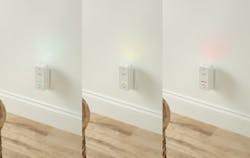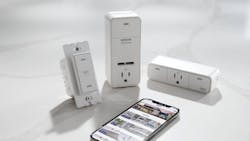Smart technology has crept into every part of a home imaginable, from water flow to ovens, laundry machines to toilets. Smart, automated tech now comes available for indoor air quality and ventilation thanks to Broan-NuTone.
The residential ventilation manufacturer says its Overture system is the only fully automated fresh air system that monitors and optimizes indoor air. It releases at a time when indoor air quality is making its way into the mainstream construction discussion. The product won a Best of IBS 2023 award for Best Indoor Product and Gold recognition in the Healthy Home category from the MVP Awards 2022.
The Whole-Home System
The Overture system monitors and optimizes air in the home by connecting different ventilation systems to its collection of sensors and controls.
Once a sensor detects a drop in air quality, either caused by increased humidity, carbon dioxide, or small particles, the system reacts by triggering the nearest ventilation system. This could be ventilation fans in the laundry rooms and bathrooms, a range hood in the kitchen, or the home’s supply fan or ERV/HRV.
Overture features three products: a room sensor, wall control, and smart plug. Homeowners can check the air quality in different rooms through the phone app and control the Overture system. It’s also voice-controlled through Amazon Alexa and Google. The system can be installed in new builds and remodels.
A Look at Indoor Air Quality Trends
Americans spend 90% of their time indoors, but indoor air can be two to five times more polluted than outdoor air, according to the Environmental Protection Agency (EPA). And think about it: those more susceptible to harm from pollutants, such as young children and older adults, are more likely to spend time indoors, says the EPA.
The effects of poor indoor air quality can be headaches, dizziness, respiratory disease, cancer, and irritations of the eyes, nose, and throat.
The topic of indoor air quality became a larger concern for more Americans, and construction pros alike, due to COVID. Not to mention COVID kept more families indoors and created lasting trends, such as increasing the number of remote and hybrid workers. Even cooking on a gas stove releases nitrogen dioxide and airborne lung irritants, according to Harvard University.
Indoor air quality improvements come at the same time as extremely tight, insulated homes. This minimizes the air exchange rate, requiring mechanical systems to supply clean air. In addition, more designers, contractors, and homeowners are knowledgeable about volatile organic compounds, or VOCs.
Common sources of VOCs include manufactured products such as paint, fabric, furniture, carpet, cabinetry, and laminate flooring.
Also concurrent with indoor air quality interest and tight homes is the strong desire for greater indoor-outdoor connection, an ongoing design trend that accelerated in recent years. The EPA cites the outdoors as a source of pollutants. These pollutants can enter as people reenter homes, bringing in dust and soil, or when windows are open, welcoming in outdoor air pollution.

